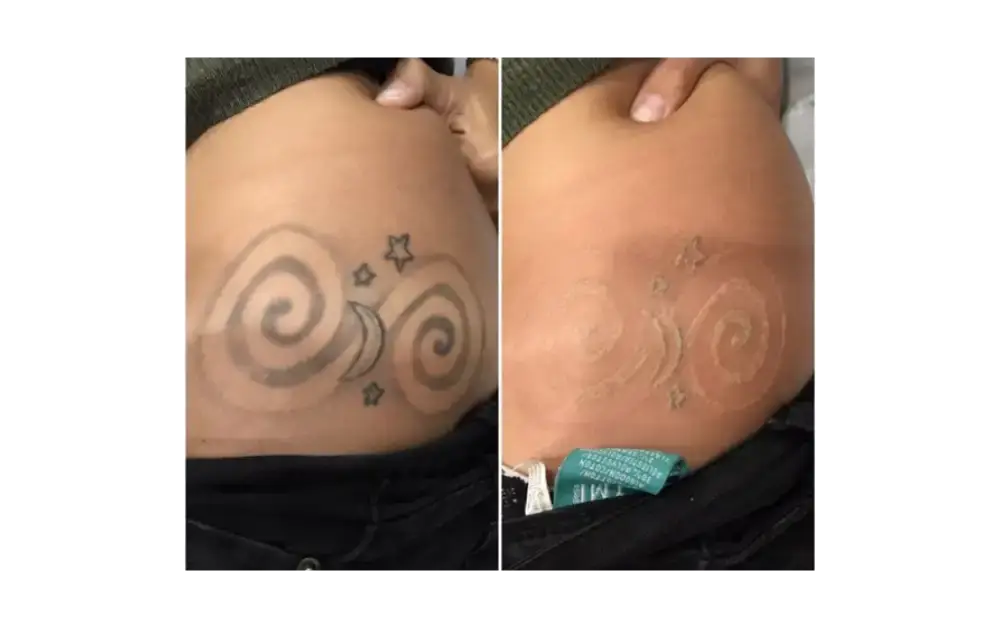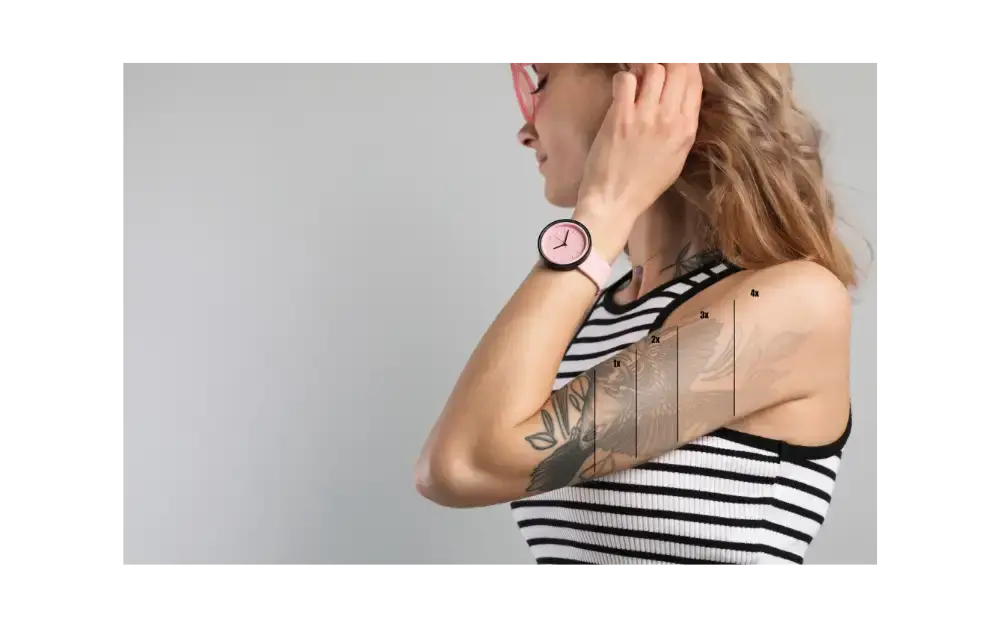We’ve all been there; a tattoo you once loved now feels like a mistake. You may be wondering about tattoo removal before and after and how the process works. Worry no more; we’ve got all the information you need to decide to remove that unwanted ink.
Tattoo removal has come a long way in recent years, with various methods available to help you achieve a clean slate. From laser treatments to surgical removal, each approach has its pros and cons. In this article, we’ll dive into the world of tattoo removal, discussing the different techniques, what to expect, and how to plan for the best results. So, let’s get started and help you feel confident in making the right choice for your tattoo removal journey.
What is Tattoo Removal?
When it comes to tattoo removal before and after, there are various methods and procedures that one can choose from to get rid of unwanted tattoos. In this section, we will explore what tattoo removal is and the different techniques used to achieve it. We’ll then go into the process of tattoo removal and what you can expect.
Types of Tattoo Removal Methods
There are several techniques available for removing tattoos, each with its own set of advantages and disadvantages. Some of the most common methods include:
- Laser tattoo removal – This is the most popular and effective method, using pulses of light directed at the skin to break down the ink particles. Through several sessions, the tattoo gradually fades away. It’s crucial to note that multiple treatments are required for complete removal.
- Surgical removal – This invasive method involves cutting out the tattooed skin and stitching the remaining skin together. Surgical removal is more appropriate for small tattoos and might not be suitable for larger or more intricate designs.
- Dermabrasion – This technique involves sanding away the tattooed area’s layers with an abrasive instrument. Dermabrasion is generally more painful and less effective than laser tattoo removal.
Process of Tattoo Removal before and after
The process of tattoo removal varies depending on the method chosen. Here’s a brief overview of the steps involved for each method:
- Laser tattoo removal: After a consultation with a professional technician, a numbing cream may be applied to the tattooed area. Then, the technician will use a specialized laser device to target and break down the ink particles. You should expect to undergo multiple sessions, typically spaced 6 to 8 weeks apart, to let the skin heal and prevent scarring.
- Surgical removal: First, a consultation with a surgeon is necessary to determine whether surgical removal is the best option for you. During the procedure, local anesthesia is administered, and the tattooed skin is carefully removed. Stitches are then placed to close the wound, and the healing process begins, which may involve some scarring.
- Dermabrasion: The process starts with a consultation to determine the tattoo’s suitability for dermabrasion. Either numbing cream or local anesthesia is applied before the procedure. Then, an abrasive instrument is used to sand away the tattooed skin. Aftercare is essential to prevent infection and scarring.

Each method has its own set of risks, benefits, and aftercare requirements. Be sure to consult with a professional to determine the best option for your individual needs and desired results.
Before Tattoo Removal
When considering tattoo removal, it’s essential to know what to expect during the process. In this section, we’ll explore the steps taken before the tattoo removal, such as having an initial consultation and preparing for the treatment. Let’s dive in!
Consultation
Before getting started with tattoo removal, it’s crucial for us to have a thorough consultation with a professional. During this time, we should discuss our expectations, medical history, and any potential risks associated with the procedure. The expert will evaluate our tattoo, taking into consideration factors such as its size, color, and location. Additionally, they’ll provide an estimate of how many sessions may be required to achieve the desired results.
Preparation
Preparing for our tattoo removal before and after is an essential part of ensuring a successful procedure. Here are a few key steps to follow before the treatment:
- Avoid sun exposure: It’s crucial to keep the tattooed area out of the sun for a few weeks before the removal process. If sun exposure is unavoidable, be sure to apply sunscreen with an SPF of 30 or higher.
- Shave the area: We should shave the tattooed area a day before the procedure to help the laser energy penetrate the skin more effectively.
- No lotions or creams: Refrain from applying any lotions, creams, or topical ointments to the area before the procedure, as these may interfere with the process.
- Stay hydrated: Drinking plenty of water before the treatment will help our skin stay hydrated and healthy during the procedure.
- Avoid blood-thinning medications or substances: In the days leading up to the appointment, avoid consuming substances such as alcohol, aspirin, or other blood-thinning medications, as they may cause increased bruising or bleeding.
By following these guidelines and ensuring proper consultation and preparation, we can effectively set ourselves up for a successful tattoo removal before after experience.
During Tattoo Removal
As we dive into the tattoo removal before and afterwards experience, it’s important to understand what happens during the process. In this section, we’ll discuss pain management and go through the procedure steps to give you a clearer picture of what to expect.
Pain Management
During a tattoo removal session, pain management is crucial. Many people compare the sensation of laser tattoo removal to the feeling of a rubber band snapping against the skin. To help make the experience more comfortable, here are some options to consider:
- Topical numbing cream: Applying a numbing cream over the tattooed area can help alleviate some discomfort.
- Ice packs: Using ice packs before and after the procedure can help to numb the area and reduce any swelling.
- Pain relievers: Over-the-counter pain relievers like ibuprofen or acetaminophen before the treatment may help reduce pain during the session.
It’s essential to discuss pain management options with your tattoo removal specialist to determine the best approach for your needs.
Procedure Steps
- Preparation: Before the treatment begins, the area will be cleaned, and a numbing cream may be applied if desired. Protective eyewear will also be provided to ensure your safety during the procedure.
- Laser application: The specialist will then use a specialized laser to target the tattoo’s ink particles. The laser’s energy will break down the ink into smaller particles, which can be safely eliminated by your body’s immune system.
- Post-treatment care: After the session, an antibacterial ointment and a sterile dressing will be applied to the treated area. Your specialist will provide you with detailed aftercare instructions to ensure proper healing and prevent any complications.
Keep in mind that multiple sessions are often required to achieve the desired tattoo removal before after results. The number of sessions will vary depending on factors such as the size, color, and age of the tattoo, as well as your individual skin type and healing process.
Post Tattoo Removal
As a part of your tattoo removal before after journey, it’s important to take care of your skin both immediately and in the long run. We’ve gathered essential tips to ensure your tattoo removal process goes as smoothly as possible.
Immediate Aftercare
Immediately after your tattoo removal session, you may experience swelling, redness, and a sunburn-like sensation. Here are a few steps to help your skin recover:
- Keep the area clean and dry: Gently wash with soap and water, then pat dry with a clean towel.
- Apply an antibiotic ointment: This helps prevent infection and can aid the healing process.
- Use a cold compress: This can help reduce swelling and discomfort.
Long-Term Aftercare
Once your skin has begun to heal, it’s crucial to provide ongoing care to promote optimal healing and minimize side effects. Some tips for long-term aftercare include:
- Stay out of the sun: Protect the treated area from direct sunlight, and apply a sunscreen with an SPF of 30 or higher.
- Avoid soaking in water: Refrain from swimming or soaking in baths for the first few weeks to prevent irritation.
- Do not pick at scabs: Allow any scabs or blisters to heal naturally to minimize the risk of scarring.
Potential Side Effects
While rare, some side effects might occur after tattoo removal. These may include:
- Blistering: This is a common side effect that generally occurs within 24 hours of treatment. Do not pop blisters, as this can increase the risk of infection.
- Scarring: Although laser tattoo removal is designed to minimize scarring, it can still occur in some individuals.
- Changes in skin color: Some individuals might experience lightening or darkening of the treated skin.
Keep these tips in mind as you embark on your tattoo removal before after journey, and always consult your healthcare provider if you have any concerns or questions about the healing process.

Comparative Analysis
In this section, we will discuss what to expect before and after tattoo removal, including expected results and success rates to help you better understand the process.
Expected Results
When considering tattoo removal, it’s essential to have realistic expectations about the outcome before and after. The process involves breaking down permanent ink particles into smaller fragments, which your immune system can then remove safely from your body. The success of tattoo removal varies depending on several factors, such as the age of the tattoo, the color of the ink, and the type of laser used.
Laser tattoo removal is the most common method, and it usually requires several treatment sessions to achieve significant fading or complete removal. It’s crucial to understand that some tattoos might not be entirely removed, and multiple sessions often lead to better results afterwards.

Success Rates
Tattoo removal success rates can depend on various factors, including the experience level of the provider, the size and depth of the tattoo, the ink’s color, and the patient’s skin type. It’s essential to choose a certified and experienced provider to achieve optimal results.
It is important to be aware that various colors in tattoos react differently to laser removal. Black and dark blue inks generally have a higher success rate, while lighter colors like green, red, and yellow can be more difficult to remove. Generally, older tattoos are easier to remove than new ones since the ink has had more time to break down in the skin.
In conclusion, good tattoo removal before and after results can vary significantly depending on numerous factors. Remember to have realistic expectations and choose an experienced provider to increase the chances of success.
Our Opinion on Tattoo Removal
Tattoo removal before and after images often show significant changes, and many people seek this procedure to get rid of unwanted tattoos. In our opinion, there are certain aspects to consider before going through with this process.
Managing your expectations is crucial when it comes to tattoo removal. It’s worth noting that not all tattoos can be completely removed, and some may leave behind a faint outline or scarring. Consulting with a professional is essential to understand the potential outcomes. The removal process can vary depending on factors such as the size, color, and age of the tattoo.
In summary, it is important to do thorough research, seek professional advice, and select a reputable provider when considering tattoo removal.
FAQ
As we dive into the world of tattoo removal before after, we understand you might have some questions. We’ve gathered some frequently asked questions to help you make an informed decision about your tattoo removal.
Can a tattoo be fully removed?
The possibility of fully removing a tattoo depends on several factors, such as the size, color, and age of the tattoo, as well as the type of ink used. In many cases, tattoos can be significantly faded or almost completely removed using laser tattoo removal techniques.
However, it is important to note that some tattoo colors, like green and blue, may be more challenging to remove than others. Ultimately, the success of tattoo removal varies from person to person and depends on the specific circumstances of the tattoo.
Are tattoos still visible after removal?
While the goal of tattoo removal is to eliminate the appearance of the tattoo, in some cases, a faint residual image of the tattoo or slight discoloration might remain. This is more likely to occur if the tattoo has deeply saturated colors or if the ink penetrates the skin to a significant depth.
In general, lighter and smaller tattoos are easier to remove with minimal residual visibility. After the tattoo removal process, it is essential to follow proper aftercare instructions to minimize the risk of scarring and promote optimal healing results.
We hope this information provides a helpful overview of tattoo removal before and after.





